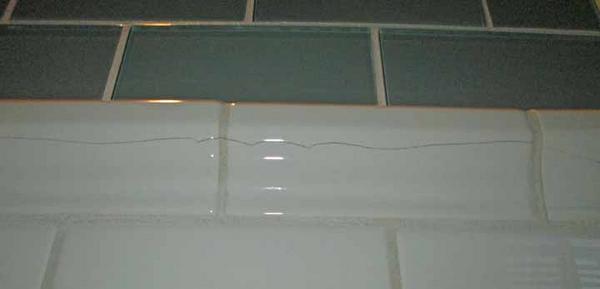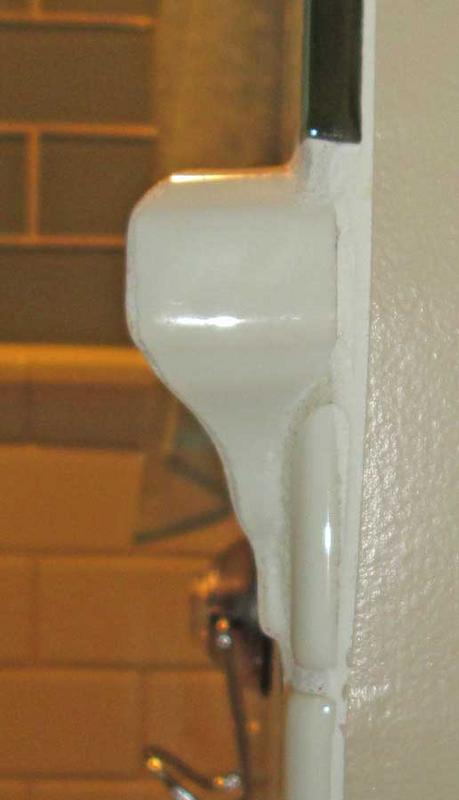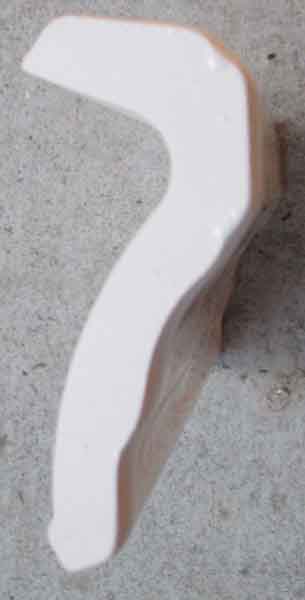JohnfrWhipple
BATHROOM DESIGN & BUILD
Today I found a simple question online on another tile forum. The fellow (Ken) is asking if the tile repair his contractors have suggested is a proper repair or a cheap band aid. He no doubt is worried about entire shower build and his brand new shower.
Lets look at the pictures he uploaded.

"Hi! I'm a homeowner who had his bathroom gutted and re-done ~six months ago by a large, reputable company, specializing in kitchen/bath remodels.
As part of this process, the shower was demoed down to the studs, new floor pan, new plumbing, new wallboard (waterproof, can't recall the product name) and tile. The tile consists of ceramic subways from floor up to a matching "chair rail", topped by glass subways to the ceiling. Two tiled wall niches were provided for using the same tiles.
Yes, it looks terrific, but six months later most of the chair rail tiles are exhibiting lateral hairline cracks on the lower side of the bullnose. The company stands behind their work, but their suggested repair consists of removing the cracked tiles and re-installing using sanded caulking, which will match the existing grout.
Does this seem a reasonable solution or is this a cheap and easy fix to a more substantial problem with the initial install? I'd appreciate any help and advice before I let them proceed. I'm happy to post pics after the requisite three posts, if that will help.
Thanks in advance," - Source *


I suspect that the installer of these Chair Rail Tiles filled the back side of the pieces with thin-set. I suspect that the thin-set was mixed a little loose. And over time the thin-set has started to shrink to the point where it finally failed the chair rail detail.
Concrete shrinks when it cures. Thin-set should not be set heavier than 1/4". Had the installer on this job used a product like Ardex X-32 for these pieces or the pre-fill step. I'm sure her shower would be looking a lot better.
Should this fellow let his tile crew do a hack repair job on it..... HELL NO. They need to come out and get installed properly. Not installed with sanded chalking.
This flaw in Ken's shower simply highlights the importance of proper thin-set selections and proper applications. We do not know the brand of waterproofing used or if one was in place.
Another tile man on the other forum suspected that the chair rail tiles might have no thin-set filling the void. I suspect the later. And all of this is related to over water thin-set and too thick of an application.
In the tile industry there is a growing surge in Indent Fractures. This would be my guess.
On the flip side another sceneriao might be that the glass tile is expanding and causing stress on the chair rail. Perhaps the tile is installed tight to the ceiling with no room to breathe.
Maybe the glass tiles where not installed with the proper directional arrows considered.
Many scenarios.
Lets look at the pictures he uploaded.
"Hi! I'm a homeowner who had his bathroom gutted and re-done ~six months ago by a large, reputable company, specializing in kitchen/bath remodels.
As part of this process, the shower was demoed down to the studs, new floor pan, new plumbing, new wallboard (waterproof, can't recall the product name) and tile. The tile consists of ceramic subways from floor up to a matching "chair rail", topped by glass subways to the ceiling. Two tiled wall niches were provided for using the same tiles.
Yes, it looks terrific, but six months later most of the chair rail tiles are exhibiting lateral hairline cracks on the lower side of the bullnose. The company stands behind their work, but their suggested repair consists of removing the cracked tiles and re-installing using sanded caulking, which will match the existing grout.
Does this seem a reasonable solution or is this a cheap and easy fix to a more substantial problem with the initial install? I'd appreciate any help and advice before I let them proceed. I'm happy to post pics after the requisite three posts, if that will help.
Thanks in advance," - Source *
I suspect that the installer of these Chair Rail Tiles filled the back side of the pieces with thin-set. I suspect that the thin-set was mixed a little loose. And over time the thin-set has started to shrink to the point where it finally failed the chair rail detail.
Concrete shrinks when it cures. Thin-set should not be set heavier than 1/4". Had the installer on this job used a product like Ardex X-32 for these pieces or the pre-fill step. I'm sure her shower would be looking a lot better.
Should this fellow let his tile crew do a hack repair job on it..... HELL NO. They need to come out and get installed properly. Not installed with sanded chalking.
This flaw in Ken's shower simply highlights the importance of proper thin-set selections and proper applications. We do not know the brand of waterproofing used or if one was in place.
Another tile man on the other forum suspected that the chair rail tiles might have no thin-set filling the void. I suspect the later. And all of this is related to over water thin-set and too thick of an application.
In the tile industry there is a growing surge in Indent Fractures. This would be my guess.
On the flip side another sceneriao might be that the glass tile is expanding and causing stress on the chair rail. Perhaps the tile is installed tight to the ceiling with no room to breathe.
Maybe the glass tiles where not installed with the proper directional arrows considered.
Many scenarios.
